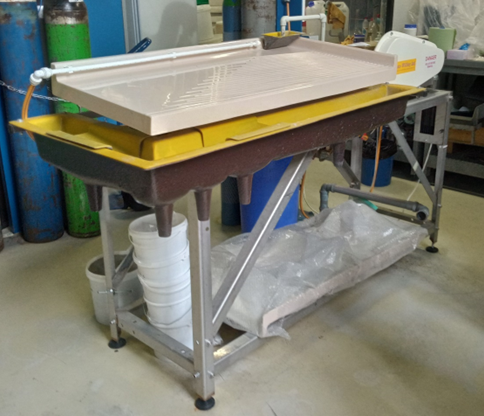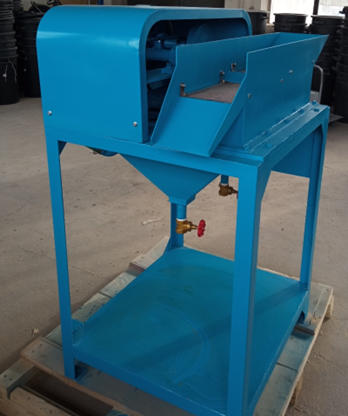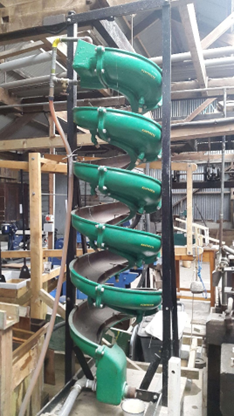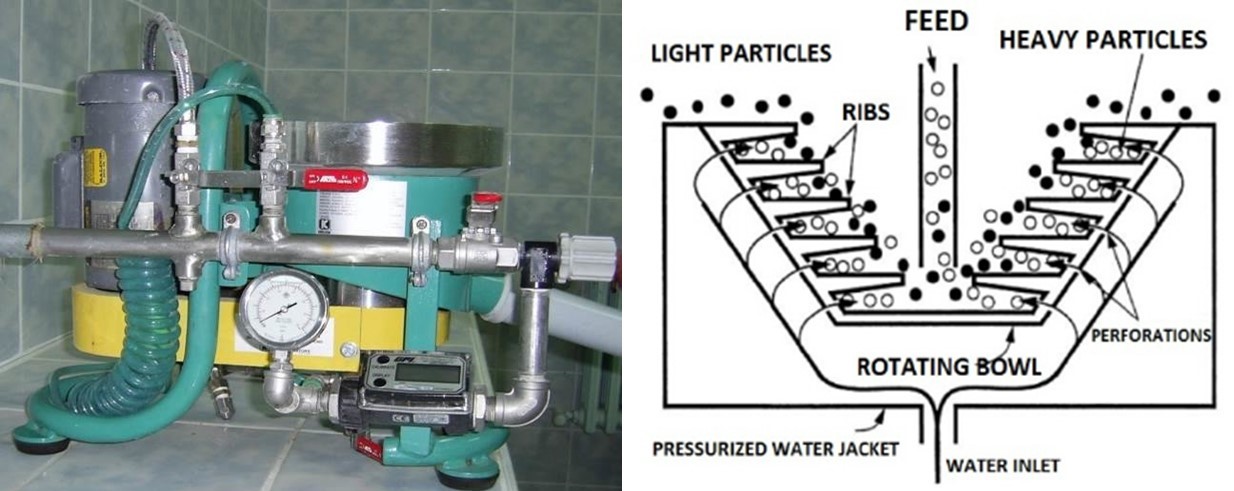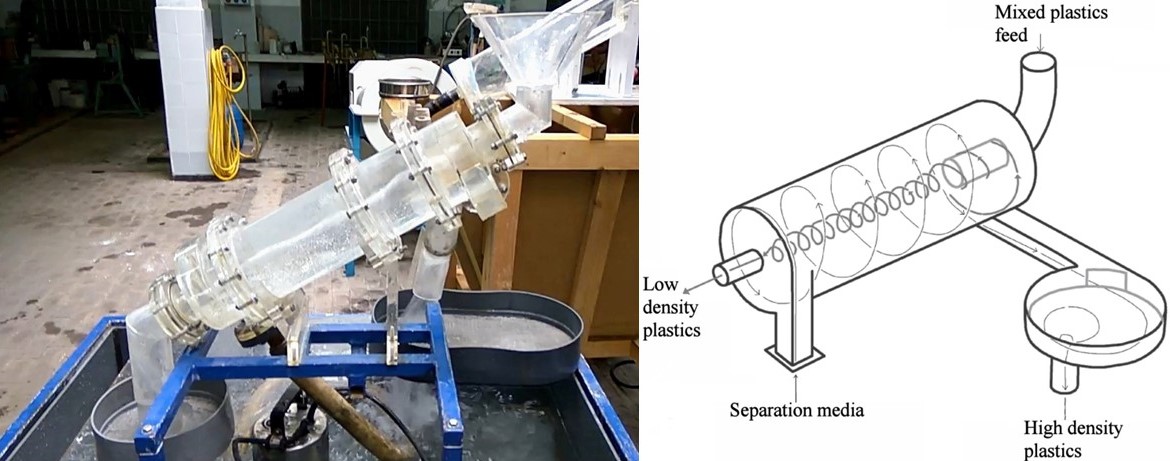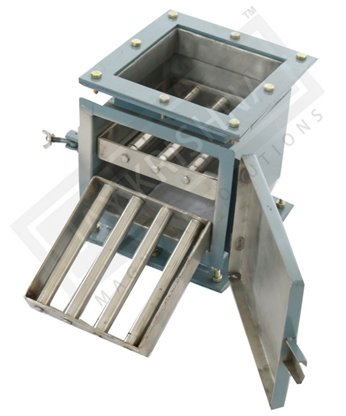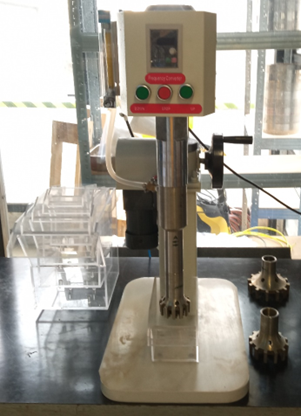Physical concentrator devices
The equipment is designed to facilitate the concentration of materials based on their distinct physical properties. These properties encompass density, magnetism, viscosity, and hydrophobicity. Taking advantage of these characteristics, the devices can effectively concentrate different materials.
Density-based Separator
Gravimetric Concentrator
Density concentration equipment is widely used in the mining and recycling industry. It consists of a table with a series of horizontal “riffles” that are constantly shaken. Additionally, the equipment incorporates a continuous flow of water to enhance the classification process. The material to be treated, with a maximum size of 2.5 millimeters, is classified along the table from the finest and densest material to the coarsest and lightest. The facility is equipped with laboratory-scale equipment, offering the capability to adjust most of the operating parameters of the equipment. It has a treatment capacity of up to 80 kg/h of material.
Gravimetric concentration equipment exploits the variations in sedimentation velocity based on the specific density of materials. This equipment comprises two chambers with a grate positioned at different heights. The introduced material experiences pulsating water action, flooding the chambers in an ascending manner. As a result, the material undergoes a jigging process during each pulse, leading to the classification of dense material concentrates with exceptional purity. The facilities boast a laboratory-scale jigging device, capable of handling materials up to 6 millimeters in size and offering a sample treatment capacity of up to 5 kg.
Gravimetric concentration equipment is extensively utilized in the coal-washing industry and for concentrating iron ores. The equipment comprises a set of descending spirals through which the material flows in the form of slurry. Thanks to the centrifugal force generated, the material is classified based on its density, with the denser components accumulating in the inner part of the spiral, while the lighter materials gather on the spiral walls.
The research group possesses laboratory-scale spiral equipment capable of treating materials up to 1 millimeter in size, with an approximate production capacity of around 100 kg/h.
Centrifugal Concentrators
The gravimetric concentration equipment combines the differential sedimentation speed of materials based on their density with the application of centrifugal force, resulting in the production of highly purified concentrated materials. The device features a high-speed rotating micro-perforated cylinder with grooves. Water is introduced through these grooves, creating a fluid bed wherein the denser material gets trapped in the grooves, while the less dense material moves towards the outer edge along with the water. The existing equipment at the facility is capable of treating samples of several hundred grams, accommodating sizes up to 800 microns.
Dense Medium Separator
Originally designed for coal mineral concentration, this equipment is currently employed in heavy mineral concentration plants and the recycling industry for plastics and WEEE (Waste Electrical and Electronic Equipment). The system consists of a cylindrical separation chamber with a 30° horizontal inclination. The separation process occurs using a dense medium that is tangentially fed under pressure into the lower part of the separation chamber. Simultaneously, the material to be sorted can be introduced along with the dense medium or from the upper part. As the dense medium enters the chamber, it creates a vortex at the center, allowing light particles (with lower density than the dense medium) to flow through the vortex surface and exit the device from the bottom. On the other hand, particles with higher density than the dense medium sink and leave the device tangentially at the top of the separation chamber via the vortextractor. The facility is equipped with three laboratory-scale devices of different sizes, capable of treating solid particles ranging from 300 microns to 2 centimeters.
Magnetic Separator Devices
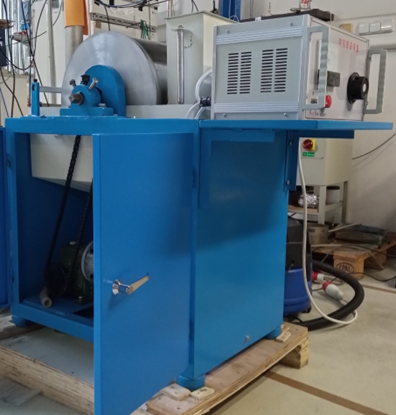 Wet Low-Intensity Magnetic Separator
Wet Low-Intensity Magnetic Separator
WLIMS (Wet Low-Intensity Magnetic Separator) is specifically designed to recover ferromagnetic and highly paramagnetic materials through the application of a low-intensity magnetic field, typically measuring less than 0.3 Teslas, in a wet media. The material to be separated is introduced as a sludge from the side of the drum opposite the electromagnet. During the treatment process, the magnetic fraction is attracted to the electromagnet and subsequently discharged on the side opposite to the feeding box. On the other hand, the non-magnetic material is collected from the bottom of the tank, completing the separation. At the facility, an existing laboratory-scale device is utilized for this purpose capable of treating particles smaller than 2 millimeters and has a treatment capacity of 60 kilograms per hour.
The device is specifically designed to recover ferromagnetic and highly paramagnetic materials by utilizing a low-intensity magnetic field, typically measuring less than 0.25 Teslas, in a dry media. The equipment comprises a cubic chamber that is open at the top and bottom. Within this chamber, two sets of bars are installed, each equipped with permanent magnets The material to be sorted is introduced through the upper part of the chamber, and the non-magnetic material is collected from the lower part. Meanwhile, the magnetic material becomes attached to the bars and can be manually recovered. At the facility, the existing equipment is capable of treating materials up to several centimeters in size and boasts a treatment capacity of 100 kg/h.
Flotation Concentrators
Equipment designed to take advantage of the hydrophobic properties (water-repellent nature) of solids. It consists of a cell filled with water that houses a rotor through which a stream of air is injected to originate bubbles. Additionally, chemical elements are introduced into the cell along with the material undergoing classification. These chemicals serve a dual purpose – activating the hydrophobicity of the desired elements and promoting foam formation.
Throughout the treatment process, the hydrophobic material efficiently adheres to the air bubbles, enabling its separation from the mixture, and subsequent removal from the cell alongside the generated foams. On the other hand, the hydrophilic material remains within the cell, allowing for precise and effective classification.
The institute is equipped with a cutting-edge Denver model cell, capable of handling cells up to 20 liters in capacity, catering to a wide range of research and industrial applications. Depending on the material being treated, the system accommodates particles of up to 500 microns in size, showcasing its adaptability and versatility.
